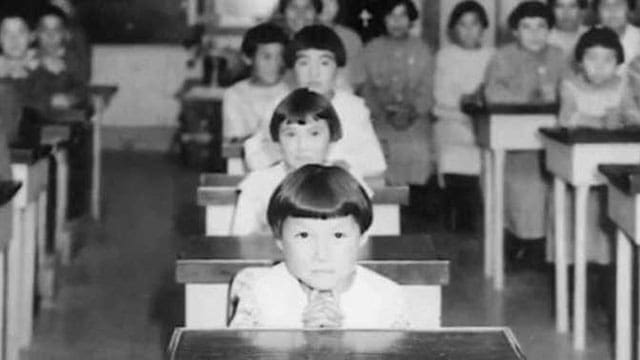 In the fall of 1973, six-year-old Phyllis Webstad’s grandmother took her to the local general store and bought her an orange shirt for her first day of school. She was proud of this beautiful new shirt and beamed as she wore it.
In the fall of 1973, six-year-old Phyllis Webstad’s grandmother took her to the local general store and bought her an orange shirt for her first day of school. She was proud of this beautiful new shirt and beamed as she wore it.
But when Phyllis arrived at St. Joseph Mission Residential School near Williams Lake, B.C., the shirt was taken from her and she had to wear the school uniform.
You would think young Phyllis would be told that she could keep her shirt and wear it for special occasions. She wasn’t. The beautiful, precious shirt her grandmother gave her was never returned.
In fact, Phyllis saw other children at the school wearing it. She knew that it was hers and she said so, but no one listened. One can only imagine the confusion and sadness this child experienced.
These feelings went unresolved for many years.
It’s said that our greatest sufferings can bring about our greatest triumphs. Forty years later, Phyllis spearheaded the Orange Shirt Day movement to raise awareness about crimes committed against aboriginal children between 1831 and 1996 in the residential school system, and to promote healing.
Today, Canadians wear orange shirts on Sept. 30 to honour the children who endured residential schools.
The intent of the residential school system was “to kill the Indian in the child,” according to historic documents. All that these people held dear was taken away. For generations, children were forced to leave the warmth of their families to attend cold, overcrowded institutions where abuse was rampant.
Children and their parents often didn’t see each other for years. Villages were void of laughter, and parents and grandparents had no one to teach. Children, far away at the schools, had no one to wipe away their tears.
In these institutions, children were not allowed to speak their language or to learn their traditions. They were taught to do manual labour deemed worthy by white culture, instead of the work their people had done for centuries, work that allowed them to thrive in the harsh Canadian environment. Ironically, they had taught the skills of their culture to the first European settlers so they could avoid dying of hunger, cold and scurvy.
It’s significant to note that the 1948 United Nations Genocide Convention defines genocide in part with this phrase: “Forcibly transferring children of the group to another group.” Is it any wonder that Canada expressed reservation about the document and didn’t ratify it until 1952?
Indeed, it was not until 2008 that the Canadian government officially apologized to the victims of these schools, and it was not until 2015 that the government-appointed Truth and Reconciliation Commission officially referred to the residential school system as “cultural genocide.”
The impact of the residential school system has been devastating. It has resulted in the virtual loss of languages and traditions. It has ravaged a once-healthy family system. It has contributed to severe health issues among the aboriginal populations. Numerous other social indicators demonstrate that healing is required for First Nations people, from above-average rates of incarceration to similarly high rates of violence against aboriginal women.
When we acknowledge where our problems come from, we can begin to do something about them. And today, in the wake of the Truth and Reconciliation report, we see a resurgence of aboriginal culture. There is reason, then, to believe that things are getting better.
As more and more of us participate in Orange Shirt Day, we not only honour the victims of Canada’s residential school system, we become a part of our nation’s very necessary journey of healing and reconciliation.
Gerry Chidiac is an award-winning high school teacher specializing in languages, genocide studies and work with at-risk students.
The views, opinions and positions expressed by columnists and contributors are the author’s alone. They do not inherently or expressly reflect the views, opinions and/or positions of our publication.


